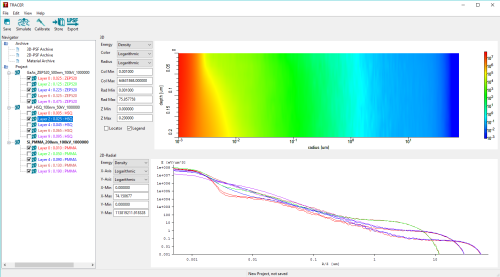
Electron scattering and process effects quantified
TRACER is a Monte Carlo simulator that computes the electron-solid interaction of any arbitrary material stack and performs advanced process calibration for electron beam proximity effect correction.
Fast, Easy and Accurate PSF Simulation and Visualization
Manage, Maintain and Archive all PSFs with an Interface to BEAMER & LAB
A Point Spread Function (PSF) is the essential input for any type of Proximity/Process Effect Correction (PEC) or e-beam simulation. A PSF describes the deposited energy as a function of the distance from the incident beam. In other words, a PSF can be described as the convolution of the electron scattering beam size (or beam blur) and process effects, which can include collateral effects from resist development and pattern transfer. The quality of a process effect correction depends entirely on the knowledge of the PSF and process correction parameters such as base dose and process bias. As such, a necessary starting point is a high-quality Monte Carlo (MC) simulation of not only electrons backscattered from the substrate, but also fast secondary electrons from both the primary exposure and backscattering events.
TRACER offers an easy-to-use interface for defining the required parameters (material data, stack parameters, acceleration voltage), running the MC simulation, visualizing the 2D r-z simulation results (energy spread at different resist thicknesses) and extracting the 1D PSF which can then be used for PEC.
The comprehensive material database includes all standard materials and can easily be expanded with custom materials by defining the new material's stoichiometry and mass ensity. Functionalities such as fitting to Gaussian functions, averaging, convolution of PSFs, determination of base dose factors between PSFs and powerful visualization enable the user to analyze, compare and optimize PSFs.
ln addition tool and process effects such as spot size, lateral development, resist diffusion and loading effects need to be quantified and corrected. TRACER has an easy-to-use Calibration feature which determines and corrects these effects using measured CD data (typically CD as a function of dose and layout density) obtained after processing of a calibration pattern. Process parameters such as base dose, process blur and process bias are rapidly computed and the display of calibration versus measured data allows the user to immediately verify the fit quality.
TRACER Major Features
Monte Carlo Simulation
- Easily-defined stack
- User-defined number of electrons
- Automatic or custom grid spacing
- Live updating during simulation
- Store a PSF directly into the library shared with BEAMER
Analysis & Computation
- Model fitting with 2-4 Gaussians
- Averaging of PSFs
- Convolution of PSFs
- Calculation of relative base dose between PSFs
Visualization
- 2-D and 1-D plotting of energy distribution
- Electron trajectory plots
- Highly-customizable plots
Material Library
- Library of common materials
- Metals, semiconductors, insulators, resists
- Easy for users to add additional materials
Process Calibration
- Based on exposure and measurement of critical CD through dose and density
- Determines base dose, process blur, process/metrology bias, lateral development
- Usable by BEAMER to correct for full process effects
- 2-Stage fitting for more accurate results
GenISys products share highly dedicated support, have flexible licensing and are available on various platforms/operating systems.
Flexible licensing and platform support
- USB license key for standalone and network
- Flexible on off-the-shelf PCs (> 4 GB RAM recommended)
- Windows 10 64bit, Linux64bit (Red Hat 6+, Ubuntu 18.04)
- Multithreaded processing
Maintenance and Support
- Technical Support Hotline (e-mail, screen sharing or phone)
- Frequent updates with new features, enhancements and bug fixes
- Regional trainings, technical workshops and user meetings
- 12 months maintenance service included in license price
- User feature requests are given high-priority for future updates





